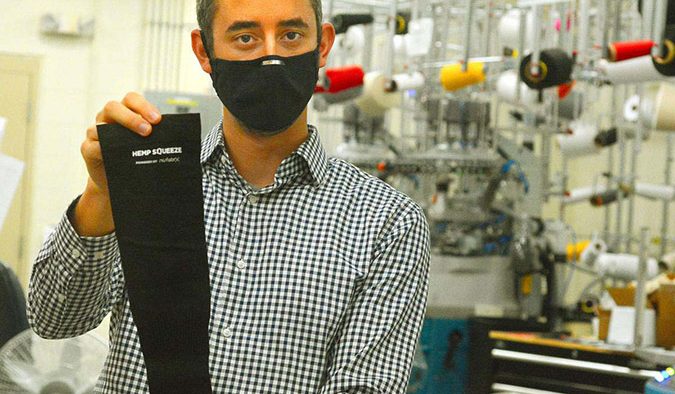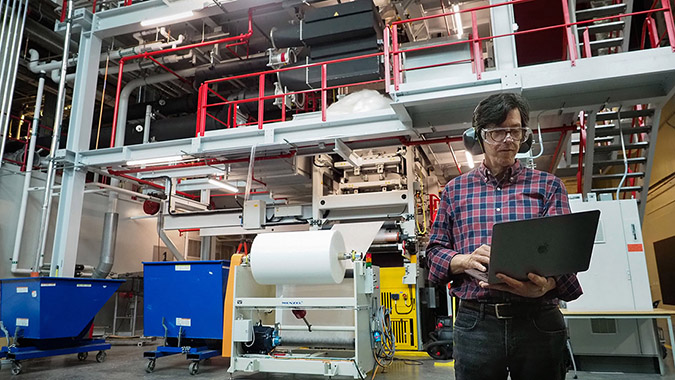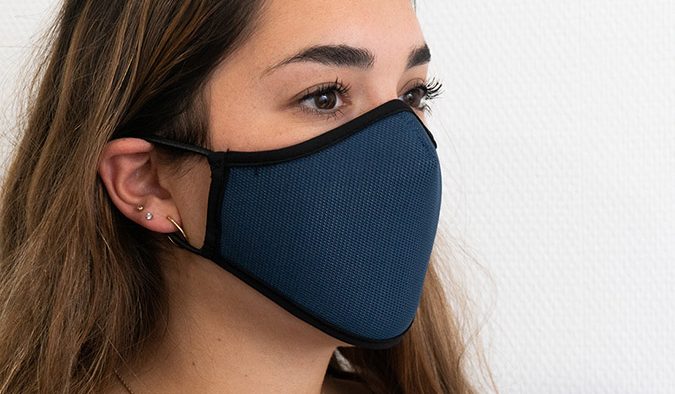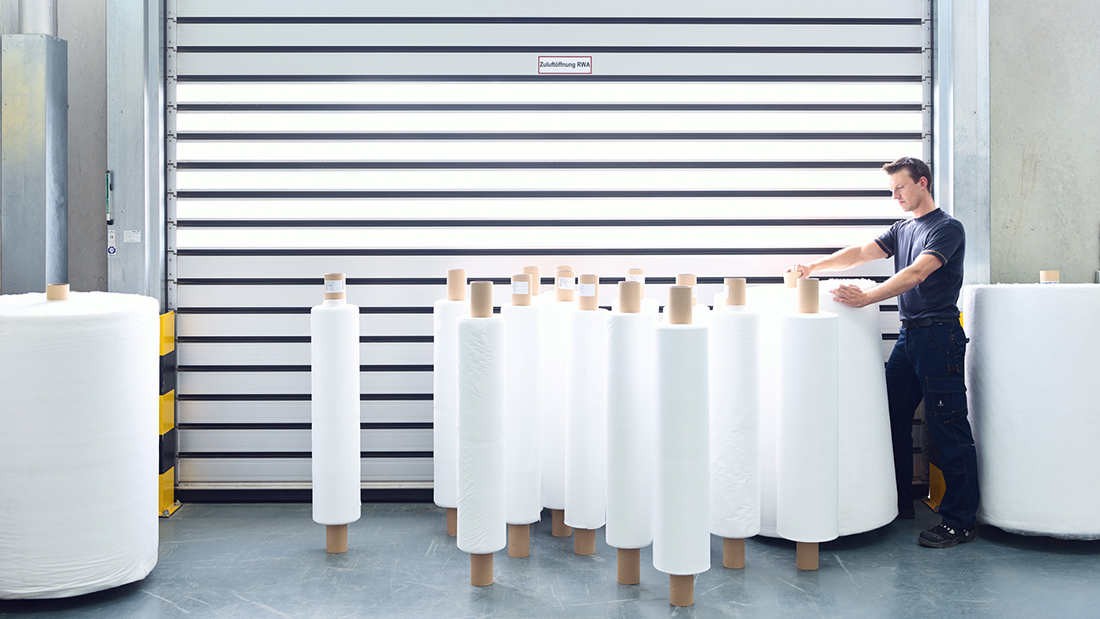With shortages of PPE constantly making headlines over the past few months, the COVID-19 pandemic has emphasized, more than ever, the world’s current reliance on synthetic polymers and fibers in single-use disposables.
Where will this leave initiatives to develop more sustainable fibers and encourage longer lasting products, with the end goal of eventually achieving a circular economy?
Facemasks
A number of unique factors led to the international trade disputes that have raged in March and April over the supply of disposable facemasks for frontline workers and hospital staff.
A big bottleneck in meeting the huge surge in the demand for masks meeting N95 levels of efficiency – filtering 95% of contaminants down to the size of 0.3 microns – has been largely due to the lack of availability of meltblown polypropylene nonwovens.
Meltblown nonwoven beams are most typically integrated into composite systems with spunbond beams (SMS materials) for the absorbent hygiene products (AHPs) markets.
The AHP markets, for baby diapers, feminine hygiene and continence care, however, have only surged during the current crisis, and all of the raw materials for them are in any case sold under contract many months ahead, with little spare capacity available.

Supply pipeline
In a webinar on April 28th, Brad Kalil, INDA’s director of market strategy opportunities and economic intelligence, explained the second major obstacle.
“Disposable finished goods based on nonwovens and including AHPs, generally tend to stay where they are produced, with one big exception,” he said. “Disposable medical apparel items – including facemasks, as well as surgical gowns, scrubs, caps shoe covers and disposable bedding – all have to be individually sewn, as opposed to being converted by automatic equipment as diapers and other AHPs are.”
Labor rates for sewing machinists in the U.S. average about $9 an hour, compared to $1 in China, he added.
As a consequence, in 2019 the U.S. imported some 92.5 million dozen packs of disposable medical apparel – 1.1 billion items – directly from China.
This figure does not even include facemasks, which INDA includes in its statistics under the separate filtration category.
In January 2020, the pipeline of supply from China to the U.S. was completely cut off.
Cut and sew
Apparel manufacturers across the U.S. and Europe have subsequently rallied to pivot their otherwise largely idled cut and sew operations to the conversion of disposable medical apparel, but the shortage of suitable spunmelt nonwovens, and especially meltblown for facemasks, has continued to be a problem.
Major nonwovens manufacturers including Berry Global, Don & Low, Fitesa, Innovatec, Johns Manville, PFNonwovens and Sandler have all announced investments in new meltblown installations, while the major German technology suppliers Reinfenhäuser Reicofil and Oerlikon have endeavored to shorten delivery times and given over their own pilot plants to emergency production.
With the latest Reicofil 5 system for SMS fabric production, throughput for spunbond fabrics is now up to 270 kg per hour per meter of beam width, but for meltblown it is still restricted to a maximum of 70 kg per hour per meter width – and this is the state of the art.

Filtration
Meltblown nonwovens are also widely employed by the filtration industry, where demand has also dropped with a reduction in industrial output. Here, filtration leader Mann+Hummel is shipping around 3,500 HEPA filter elements per day from manufacturing sites in the U.S. and Germany to automaker Ford, which is making powered air purifying respirators (PAPRs). PAPRs use a battery-powered blower that sends filtered air into a hood or head top and can provide increased levels of respiratory protection.
3M has also partnered with Cummins to utilize labor and equipment typically used for producing diesel engine filters to manufacture high efficiency particulate filters for PAPRs.
Cummins is using existing manpower and equipment at its Neillsville, Wisconsin facility to pleat the media, assemble it into cartridge housings and do final testing before shipping the filters to Valley, Nebraska, where 3M’s PAPRs are manufactured.
Cummins’ NanoNet and NanoForce filter media employ DuPont’s Hybrid Membrane Technology (HMT) based in nanofiber layers.
Nanofiber layers can achieve even greater efficiency than N95 requirements, of up to 99% of 0.3 microns. The industrial production of nanofibers, however, is even slower than that of meltblown nonwovens, and existing lines have very limited output.
INDA is now working with the manufacturers of sorbents for oil spill containment, as a potential further source of the vital meltblown materials.
Synergex ONE
Berry Global has rushed out a new fabric with the potential to relieve this severe bottleneck that the need for meltblown is causing.
Synergex ONE is described as “a multilayer nonwoven composite product in a single sheet” and has been initially developed to meet the new facemask categories for the general population.
The aim, however, is to quickly bring the media up to N95 standard for surgical masks.
The new material is being manufactured in Europe with immediate availability.
Bicomponent alternative
In what may or may not be a related development to Synergex ONE – Berry Global declined to either confirm or deny it, or supply any further details on its new product – the Nonwovens Institute (NWI) at North Carolina State University has created a new bicomponent spunbond material that can serve as an effective N95 filter without the need for a meltblown filtration layer.
“We took the spunbond technology and created a new generation of unique filters that have excellent filtering capability and can potentially be reused after cleaning with peroxide, or potentially alcohol solution,” said Executive Director Benham Pourdeyhimi. “Because these materials are strong, unlike classical meltblown filters, they can also be cut and sewn by traditional techniques.
“Typically, one meter of spunbond material provides enough for about 20 to 25 masks when using the current designs. One of the NWI’s production lines started producing 2,000 meters of spunbond material per hour, with the potential to create some 20,000 meters in a day.”

Sustainable fibers
The new nonwoven fabric can be based on bicomponents of Ingeo PLA biopolymer and polypropylene, and NatureWorks is donating enough Ingeo to produce as many as two million reusable N95 masks per week to the NWI.
Ingeo is said to improve the productivity of the spunbond process by at least 30%. It has been widely promoted as a sustainable alternative to synthetics, being currently based on plant sugars, with a view to eventually making it directly from greenhouse gases. The present crisis, however, calls for its sustainable attributes to be compromised.
Even cellulosics leader Lenzing – a champion of sustainable raw materials with its closed-loop Tencel production and many other initiatives – has had to put aside its principles for the time being.
Lenzing has just founded a new joint venture company with fellow Austrian company Palmers Textil which started producing and selling protective masks for the domestic and European markets in May.
The new company, Hygiene Austria, plans to build up capacity to over 25 million facemasks per month, but at the moment is having to rely on a third-party supply of spunmelt based on polypropylene, as it works to develop ways to process its own fibers.
Single use
For the time being then, there is no real substitute for synthetic fibers, but what about the single use of medical disposables, is that something that could be addressed?
In medical settings, probably not. Hospitals returning to durables and all that their sterilization entails, is as unlikely as resurgence in the use of cloth diapers, detergent and buckets by young mothers.
One area where there is the scope to do things differently, however, is in the production of disposable facemasks for consumer use, and indeed, many initiatives are already underway.
It is likely that after COVID-19 the use of face masks in everyday situations may become as commonplace in the U.S. and Europe as it is in many parts of Asia for some time.
Here, masks that can be washed a number of times and can be recycled after use make perfect sense.
The German company Bieglo, for example, has introduced three-layer polyester fabric facemasks that incorporate zinc and copper molecules to both provide antimicrobial properties and to allow their reuse.

In testing, the antimicrobial effect of the masks was shown to be still 99.9% intact after 30 wash cycles and Bieglo recommends washing them by hand or in a washing machine with a base-detergent at a maximum of 60 C.
Nufabrx, based in Conover, North Carolina, has launched reusable facemasks containing the antimicrobial benefits of copper.
The company’s Theramasks are engineered to provide dependable and sustainable protection for consumers and can be washed up to 30 times. They are currently available by mail order in the U.S. and consignments have already been delivered to the New York Police Department and other government institutions, as well as organizations such as Fed-Ex, American Airlines and a number of restaurant chains.
Two Japanese companies, TBM and Bioworks are meanwhile producing Bio Face knitted masks for consumers made from PLA yarns, with the help of technology provider Shima Seiki.
“As face mask consumption increases, the appropriate disposal of them is becoming critical,” says TBM CEO Nobuyoshi Yamasaki. “Biomass-based and reusable facemasks for the consumer market make perfect sense.”
It could be that while single-use disposables made from synthetics remain vital to hospitals and frontline workers, the growing consumer facemask market will prove a testing ground for much new sustainable innovation in fibers and fabrics.


